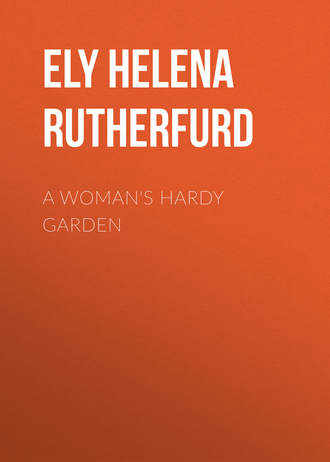 полная версия
полная версияA Woman's Hardy Garden
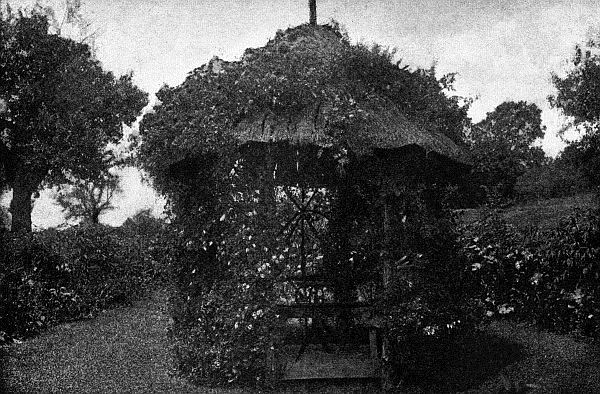
Summer-house, covered with Clematis and Crimson Rambler Roses
June twenty-first
Budded stock must be planted very deep. The joint should be at least three inches under ground. Roses grown on their own roots are more expensive than the budded stock, but a far better investment. The budded stock is apt to send up from the parent root suckers or shoots of Sweetbrier, Buckthorn, Flowering Almond, or whatever it may be. These shoots must be carefully cut off. A friend told me that, when new to Rose growing, his bed of budded Roses sent up so many strange shoots that, not knowing what to do, he dug them all up but one. This he kept as a curiosity, and now it is a bush of Flowering Almond six feet in circumference.
Everblooming Roses should be set out in the spring, about the middle of April.
Hybrid Perpetual and Hardy Roses are best set out in autumn, about October tenth. When planting, always cut the plants back to about a foot in height.
All Roses should be lifted every three years, late in October, and plenty of manure, with fresh earth and leaf-mould, mixed with sand if the soil is heavy, dug in.
After five or six years I dig up my Roses about October tenth, cut the tops down to about twelve inches, cut out some of the old wood, cut off the roots considerably, trench the ground anew, and replant. The following year the Roses may not bloom very profusely, but afterwards for four or five years the yield will be great. My physician in the country is a fine gardener, and particularly successful with Roses. We have many delightful talks about gardening. When I told him of my surgical operations upon the Roses he was horrified at such barbarity, and seemed to listen with more or less incredulity. So I asked him if, as a surgeon as well as physician, he approved, on occasion, of lopping off a patient’s limbs to prolong his life, why he should not also sanction the same operation in the vegetable kingdom. He was silent.
I shall not say much about Roses, because there is so much to say. They need a book by themselves, and many have already been written. In my garden there are not more than five hundred Roses, including the climbing varieties. They have done very well, and have not been given more care than other plants.

Rose bed carpeted with Pansies
June twenty-first
For years I did not grow Roses, fearing they would not be a success. I had read about the beetles and spiders and other creatures that attack them, and dreaded the spraying and insect-picking that all the books said must be done. But, of course, I finally yielded to the temptation of having the very flower of all flowers, in my garden, and have found the trouble slight and the reward great. I have them in beds in a little formal garden, and in rows in a picking garden.
The beds and the trenches for the rows are both made in the usual way, and every fall, in late October, before the Pansies are set out as already described, manure is dug in, and in the early spring, about the tenth of April, a handful of finely ground fresh bone-meal is stirred in around each plant with a trowel. They are sprayed with slug-shot three times between April tenth and May fifteenth, when they get a thorough spraying with kerosene emulsion, and, as a result, my Roses are not troubled with the usual pests.
In November the hardy perpetuals are all cut back to about two feet in height, and the old wood is thinned out. The everblooming Roses are cut back to a foot in height. And Roses! well, really, no one could ask better from a garden. I have not many varieties, but when I left the country last fall, the tenth of November, although ice nearly an inch in thickness had formed, there were Roses still in bloom in the garden.
The very hardy Roses, which, with a few exceptions, bloom only in June and early July, with an occasional flower in the autumn, should be planted together, as they need but slight covering. In late November the hardy ones get about a foot of stable litter over the beds. The everblooming kinds have six inches of manure, then a foot of leaves, and then a good covering of cedar branches over all. But cover late and uncover early (the very minute the frost is out of the ground), or your Roses will die.
If asked to name, from my own experience, the best dozen Roses, I should say the following were the most satisfactory: General Jacqueminot, Jubilee, Ulrich Brunner, Madame Plantier, Clothilde Soupert, Kaiserin Augusta Victoria, La France, Mrs. Robert Garrett, Princess Alice de Monaco, Soleil d’Or, Perle des Jardins, and Mrs. John Laing or Baroness Rothschild. Paul Neyron and Prince Camille de Rohan might also be added to the list.
Between Mrs. John Laing and Baroness Rothschild, it is a toss-up. Mrs. John Laing is a healthy, strong Rose, and a most constant bloomer. But none that grows is more beautiful than the Baroness Rothschild. Rather a shy bloomer; still each Rose, on its long, strong stem, surrounded by the very fine foliage that distinguishes this variety, makes a bouquet in itself. Baroness Rothschild is also vigorous, and I have never seen it attacked by the enemies of most Roses.
Climbing Roses have so much use, as well as beauty, in a garden, that my advice is, wherever there is an excuse for having one, plant it there. They do finely on the south side of a house, on arches, summer-houses and trellises. I have a trellis along one side of a grass walk three hundred and fifty feet long. At each post are planted two Roses, a Crimson Rambler and a Wichuraiana. The Wichuraiana blossoms when the Rambler is done. Imagine the beauty of this trellis when the Roses are in bloom! On the other side of this walk there is a border four feet wide, with shrubs at the back, filled, all of the three hundred and fifty feet, with many varieties of perennials, also with Lilies and annuals planted in wherever a foot of space can be found.
All of the Ramblers are good, but none blooms so luxuriantly as the crimson. The Climbing Clothilde Soupert, Baltimore Belle and Climbing Wootton are also fine. Of the Wichuraiana Hybrids, Jersey Beauty and Evergreen Gem are the best. The foliage is lovely, and the perfume of the flowers delicious.
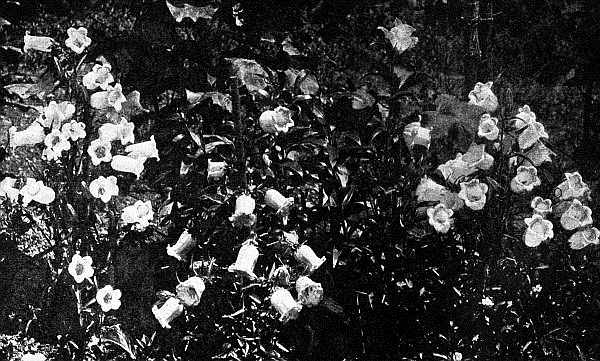
Canterbury Bells blooming in a border
June twenty-first
The Climbing Roses should be yearly enriched in the spring with manure and bone-meal, and, after two years, some old wood should be cut out every autumn. Many of the Crimson Ramblers and Wichuraiana in my garden made growth last summer of splendid great canes, larger around than one’s thumb and from ten to fourteen feet long. Monday was the day for tying and training the Roses, and often it seemed impossible for them to grow so much in a week. It would have been incredible, had we not the actual proof before our eyes.
List of Hybrid Perpetual and Hardy Roses Blooming in June, with an Occasional Bloom in September
RedGeneral Jacqueminot
Prince Camilla de Rohan, (darkest Rose of all).
Jubilee.
Baron Bonstetten.
General Washington.
John Hopper.
Ulrich Brunner.
Victor Verdier.
PinkMrs. John Laing (constant bloomer).
Anne de Diesbach.
La France (blooms all summer).
Magna Charta.
Mme. Gabriel Luizet.
Baroness Rothschild.
Paul Neyron.
WhiteMargaret Dickson.
Coquette des Alpes.
White Maman Cochet (blooms continually).
Madame Plantier (blooms continually).
Coquette des Blanches.
Mme. Alfred Carriere.
Marchioness of Londonderry.
YellowI know but two hardy yellow Roses:
The Persian Yellow.
Soleil d’Or.
The monthly or everblooming Roses, which need very heavy covering in winter, should be planted together. The following are a few of the best and most constant bloomers:
Kaiserin Augusta Victoria, white.
Bride, white.
Clothilde Soupert, white with faint blush center.
Madame Hoste, creamy white.
Perle des Jardins, yellow.
Sunset, yellow.
Mlle. Germaine Trochon, yellow.
American Beauty, rich crimson.
Marion Dingee, deep crimson.
Souvenir de Wootton, crimson.
Bridesmaid, pink.
Hermosa, pink.
Madame de Watteville, pink.
Burbank, pink.
Mrs. Robert Garrett, pink.
Princess Alice de Monaco, petals white, edged with blush-pink.
LILIES
CHAPTER XI
LILIESLilies, too, should have a book for themselves. My knowledge of them is slight. Lilium auratum (Auratum Lily), the grandest of all Lilies, disappears after a few years. If large-sized bulbs are bought there will be the first year from twenty to thirty Lilies on a stalk four feet high, the second year seven to ten, the third year perhaps two or three, but oftener none at all. If you then dig for the bulb, lo! it is gone. The expense, therefore, of these Lilies is great, from their having to be often renewed. Still, do not fail to have them, if possible, for nothing can take their place. They bloom from the middle of July for about a month.
I wrote to an authority on Lilies to ask the cause of this disappearance. He told me that, as soon as planted in this country, a microbe disease attacked them and they gradually disappeared under its ravages. Botanists surely should find a specific, or antidote for this; but perhaps, like some of the most terrible diseases of the human being, it evades all research. Miss Jekyll, in her book on Lilies for English Gardens, in speaking of Lilium auratum says:
“This grand Lily, well planted, and left alone for three years, will probably then be at its best. After this the bulbs will be likely to have increased so much that it will be well to divide them.”
This would seem to imply that the Auratums thrive in England. Well, they have climate in England, even if we have weather, and English gardens will always fill American gardeners with despair.

Lilium auratum growing behind Peonies and Columbines that bloomed earlier
August tenth
Lilium candidum, which blooms before the other Lilies, is hardy and fragrant and increases rapidly. These Lilies must have full sun and light soil. About every three or four years they can be separated, which should be done as soon as the stalks turn yellow, as the bulb makes an autumn growth. For this reason the Candidums must always be bought and planted by the tenth of September. Other Lilies may be planted in the spring, when the frost leaves the ground, or in October.
Lilium speciosum rubrum thrives and increases in our climate, needs a partly shaded location and, therefore, does well when planted among Rhododendrons. It blooms after the Auratum, the end of August and first two weeks of September.
Lilium speciosum album blooms at the same time as Lilium rubrum. It is a beautiful pure white Lily with wax-like curved petals, grows best in full sun, and averages six Lilies on a stalk, although I have often counted more.
Lilium longiflorum blooms early in July. These lilies are very much like the Bermuda Lily, except that they have, as a rule, about four blossoms on a stalk, and are hardy. In my garden they have not increased.
Hansoni, a Japanese Lily, flowering in June; bright yellow in color; perfectly hardy and very desirable.
Lilium Canadense (the Meadow Lily), yellow, red and orange, increases, and is very satisfactory, but likes as moist a situation as possible.
Tigrinum, the old Tiger Lilies, both single and double. These bloom in July, increase rapidly, and by planting, when fully ripened, the little black bulbils which form on the stalk, any number of bulbs can be raised.
Funkia subcordata is the old-fashioned white Day Lily of our grandmothers’ gardens. The broad leaves of this plant are almost as handsome as the spikes of bloom. These Lilies flower best when grown in the sun, but then the leaves turn yellow – so give them a partly shaded place.
Funkia cærulea, with the blue blossom, is worthy of a place in the garden, though far from being as effective as the white-flowered variety. I also grow the kind with the small white and green variegated leaves for the sake of the foliage, so useful in house decoration.
Funkias are not, botanically speaking, Lilies, but are mentioned in this chapter because popularly known as Day Lilies and on account of the lily-like form of their blossoms.
Lily-of-the-valley should have a place in every garden. Absolutely hardy, requiring no care, it blooms prolifically in early May, fills the air with its fragrance, and is beloved by every one. The German name for this flower, Mai Glöcken (May Bells) is particularly appropriate. I have heard of one woman whose bed of these flowers, four feet by fifty feet, has yielded as many as twenty thousand sprays in one season. The pips can be set out the end of October or the beginning of November. If the bed is quite large, when the Lilies have finished blooming, some can be lifted here and there and transplanted. As the pips increase rapidly, their places will soon be filled. Lilies-of-the-valley do best in a partially shaded place, and require a deep, rich soil, well mixed with leaf-mould.
A Lily bed should be prepared, if the place is damp and drainage not good, by digging out the soil for three feet, and putting a foot of cobblestones in the bottom; then fill up with a mixture of good soil, leaf-mould and sand, and very old, well-rotted manure. In the ordinary garden that is not wet, two feet are enough to dig out the bed, and the cobblestones can be omitted. Lilies should always be set with a handful of sand around the bulb, to prevent any possibility of manure coming in contact with it, as the manure will destroy the bulb.
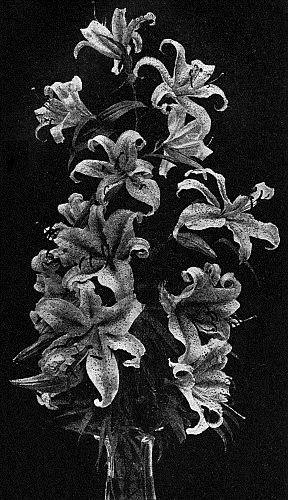
Vase of Lilium auratum
August second
In my garden there is no special place prepared for the Lilies, but they are grown in all the borders, the Rubrums in the shade, the others in the sun, and this year there have been thousands of them. If there are no woods near, where the men can gather leaf-mould, have the rakings of the autumn leaves put in a pile, cover with boards, and occasionally during the spring and summer have them well forked over; the next autumn there will be a quantity of the finest thing for Lilies, Rhododendrons, Ferns, or indeed any kind of plant. This should be mixed in a pile in the proportion of one wheelbarrow of mould, two of good soil, two coal-scuttlefuls of wood-ashes, one-half barrow of old manure and two spadefuls of fine bone-meal. There is also nothing better for the Roses than some of this mixture.
All Lilies do better if well mulched with clippings of lawn grass or with very old manure.
The varieties of Lilies mentioned are the easiest grown and the most satisfactory.
Lilies should always be planted in clumps of the same kind – never less than six, and the number increased according to the size of the garden. Alternate clumps of a dozen each of Lilium auratum and Lilium album planted in a border just behind Foxgloves and Canterbury Bells will come into bloom when these two biennials have finished, the Auratum first, then the Album; these four flowers will keep the border gay from early in June until the middle of September.
Lilies should be planted about eight inches deep, and have a covering of litter late in the autumn.
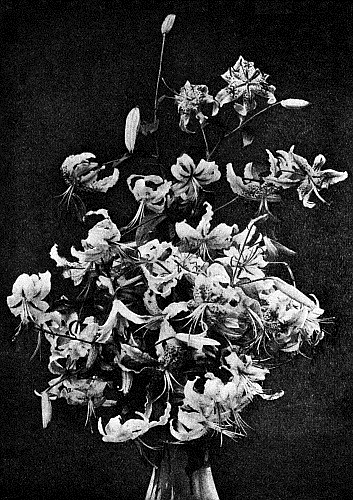
Vase of Lilium speciosum album and rubrum
September sixth
SPRING-FLOWERING BULBS
CHAPTER XII
SPRING-FLOWERING BULBSBulbs can be planted at any time in the autumn before the ground freezes; the first week in November is as good a time as any. The cost of Tulips, Narcissi and Daffodils is not great. They multiply and need not be disturbed for three or four years.
Snowdrops. The earliest of all flowers to bloom is the Snowdrop. After the long, cold winter, with the melting of the snow and the first suspicion of milder air, these frail beauties send up their graceful bells of white. With what triumph the first one is found and brought to the house, and what a thrill of joy it gives to know that spring will soon be here! Snowdrops can be planted thickly in the borders and also, like Crocuses, in the grass. The foliage of both will die before it is time to mow the lawn.
Crocuses, which should be planted in the grass, will begin to bloom as soon as the Snowdrops pass. The gay little things make the lawn, while still brown, a carpet of bright colors. I heard of a gentleman who planted ten thousand of them in this way, and was rewarded by a most beautiful display at a time when there were no other flowers.
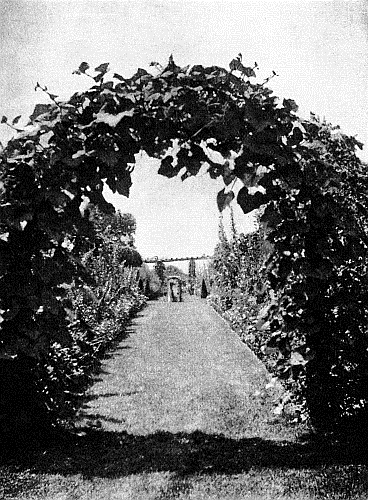
Garden arch, covered with Japanese gourds
August twenty-seventh
Tulips I plant everywhere in the borders about four inches apart, all kinds, such as single, double, Gesnerianas and Parrot Tulips; but always a quantity of only one kind together. The bed where later the Salvias are put, has three hundred Golden Yellow Tulips. When these have faded, the Salvia plants are set out in the same bed, without disturbing the bulbs. This can be done if the men are careful, and when the Tulip leaves are quite yellow they are cut off (for unless allowed to ripen the bulb does not grow and multiply). Every three years all Tulips are dug up in the autumn, after the Salvias have died; the bed is then made very rich, and the Tulips reset. There are generally more than enough to refill the bed. The same treatment is pursued in the Canna bed, only here the Tulips are double white.
Tulips will bloom from April twentieth until the last of May, if both the very early as well as the late kinds are planted. The late varieties are the Parrot and Gesneriana, which latter grow two feet high and are very showy.
I have been constantly surprised to find that many good gardeners take up all bulbs when through flowering in the spring, store through the summer and replant in the autumn. This is not only unnecessary, but it is better for the bulbs to remain in the ground as nature intended. Mine have always been so treated and have been successful.
In planting bulbs in newly prepared soil, great care must be taken that they do not come in contact with manure. To prevent this, the man should have a box of sand, in a handful of which each bulb should be set. Spring-flowering bulbs should be planted about four inches deep.
Poeticus Narcissus and Daffodils, both single and double, do well when naturalized in grass that need not be cut until the foliage of the bulb has died in June. They also make a very good edging for a border along a walk.
The single Van Sion and Emperor Narcissus are excellent varieties. The old-fashioned sweet-scented Jonquil and double Van Sion, or Double Yellow Daffodil, are as satisfactory as any of the numerous kinds named in the catalogues. One early spring, the Double Yellow Daffodils were all in bloom on the tenth of April.
Narcissi and Daffodils live for generations. I know some double yellow Daffodils growing in my great-grandfather’s garden, that were planted over seventy years ago. The place was sold and the house burned about thirty years since, and all this time has been entirely neglected. Some one told me that Daffodils and Narcissi still bloomed there bravely in the grass. With a cousin, one lovely day last spring, I took the train out to this old place and there found quantities of the dainty yellow flowers. We had come unprovided with any gardening implements, having nothing of the kind in town, and brought only a basket for the spoils, and a steel table-knife. We quickly found the knife of no avail, so borrowed a sadly broken coal-shovel from a tumble-down sort of a man who stood gazing at us from the door of a tumble-down house. The roots of the Daffodils were very deep, and neither of us could use a spade, so the driver of the ramshackle wagon taken at the station was pressed into service. Handling of shovel or spade was evidently an unknown art to him. The Daffodil roots were nearly a foot deep, but we finally got them, several hundreds of them, all we could carry. The driver seemed to think us somewhat mad and said “Them’s only some kind of weed,” but when I told him the original bulbs from which all these had come were planted by my great-grandmother and her daughter, and that I wanted to carry some away, to plant in my own garden, he became interested and dug with all his heart. The bulbs were in solid clumps a foot across and had to be pulled apart and separated. They were the old Double Yellow Daffodil and a very large double white variety, the edges of the petals faintly tinged with yellow and delightfully fragrant. My share of the spoils is now thriving in my garden. By the process of division every three years, these Daffodils can be made to yield indefinitely, and perhaps some great-grandchild of my own may gather their blossoms.
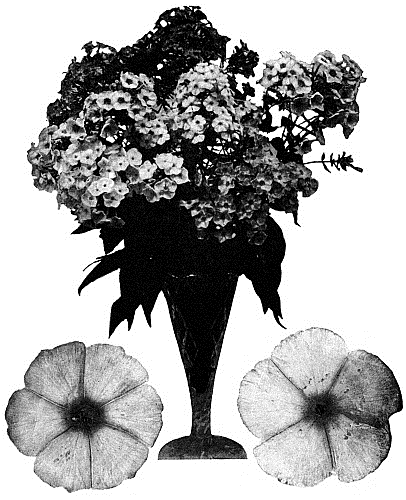
Vase of Phlox; single blossoms actual size
August second
Hyacinths, too, should have a place in the spring garden. They are more expensive, as a rule, than Tulips, Narcissi and Daffodils, but, in large or small quantities, are well worth the money. The single varieties are generally preferred, while, of all kinds, the white and pale blue are the loveliest.
Nothing in the garden gives so much pleasure as the early spring flowers. Perhaps this is because they are the first to bloom. Every one knows how beautiful the first lovely Dandelion seems, gold-starring the new grass. Many bulbs can be had for little money, and I would say to all, plant as many as you can squeeze in. From April fifteenth to May fifteenth I receive in town, twice a week, great boxes of spring flowers from my garden, enough each time to fill sixteen to twenty vases; yet my orders to the men are to cut always so that the flowers cannot be missed from the garden.
[156][157]
SHRUBS
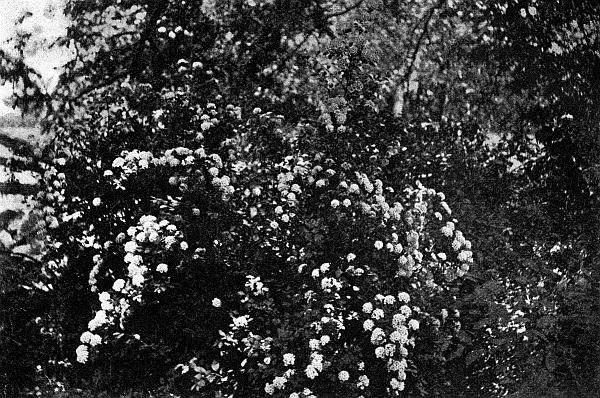
Spiræa Van Houttei
May thirty-first
CHAPTER XIII
SHRUBSOf the hundreds of shrubs, comparatively few survive the severe winter climate of interior New York, or grow very luxuriantly.
Lilacs of all varieties, white and purple, single and double; Deutzias, white and pink; and Syringa, the improved large-flowered variety, are most beautiful. Spiræa Van Houttei, sometimes called Bridal Wreath, with its long trails of white blossoms; and Viburnum plicatum, or Japanese Snowball, which in late May bears a ball of bloom on every twig and is both healthy and hardy, are also desirable shrubs. The old variety of Snowball is attacked by a blight, the leaves curl up and grow black and the blooms are imperfect. A few years ago I dug up all of mine and burned them.
Altheas, or Rose of Sharon, – not by any means the old purplish red variety, but the beautiful new double white and double pale pink kinds, with blossoms coming in August and reminding one of Camellias, – are indispensable. Do not fail to have Hydrangea paniculata, with its great heads of white bloom, slowly changing to dull pink, and lasting quite six weeks.
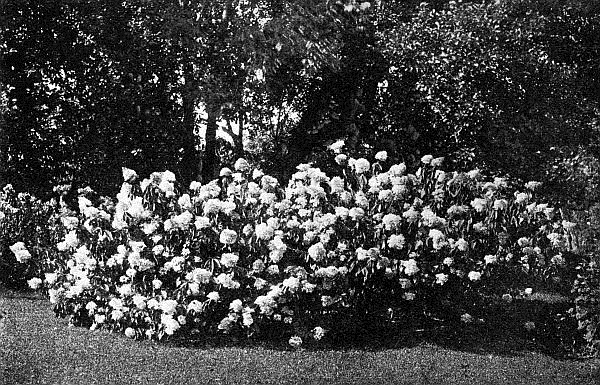
Hydrangea paniculata grandiflora
August twenty-sixth
Japanese Barberry, a dwarf shrub, covered in autumn with scarlet berries which remain on the bush all winter, is very ornamental. Many of us remember Calycanthus floridus, or the Sweet-scented Shrub of our young days, when the children would tie two or three of the queer brown blossoms in the corner of a handkerchief to regale their less fortunate companions with a sniff of the delicious odor. Forsythia and Laburnum, or Golden Chain, both have yellow blossoms. Others are, Weigela Rosea, the well-known pink-flowering shrub; Rhus Cotinus, or Purple Fringe, and Cydonia Japonica, or Japanese Quince, deep rose-pink, flowering early in the spring.

